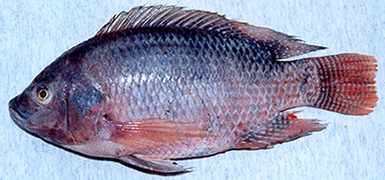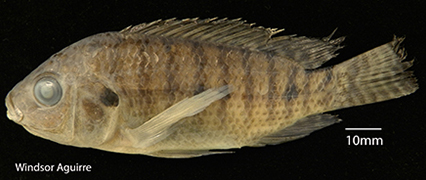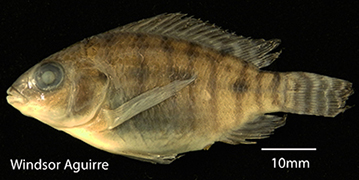Cichlidae - Oreochromis spp. |
| SOURCE FOR OCCURRENCE IN ECUADOR: Barriga (2012), Revelo and Laaz, (2012), Jimenez et al. (2015). |
| ORIGINAL DESCRIPTION: NA |
| TYPE SPECIMENS: |
| TAXONOMIC STATUS: The genus is valid. Multiple species and their hybrids have been introduced into western Ecuador. Little is known about the differences between species in the region so all species are treated together here as "tilapia". |
| RANGE ECUADOR: Introduced throughout freshwaters of all of western Ecuador (Jimenez et al., 2015). Also found around human populations east of the Andes (Windsor Aguirre, personal observation). |
| RANGE OUTSIDE OF ECUADOR: Originally from Africa, tilapia have been introduced into tropical fresh waters throughout the world (Jimenez, 2007). |
| COLLECTIONS IN ECUADOR: |
| MAXIMUM SIZE: Can grow to close to 50 cm total length in extreme cases (Jimenez et al., 2015). |
| DISTINGUISHING FEATURES: Can be distinguished from native cichlids by the following combination of characters: Tilapia have three spines in the anal fin whereas Mesoheros has four or more spines, and tilapia have very fine, small teeth while Andinoacara have larger conical teeth (Jimenez et al., 2015). Tilapia also have several broad vertical stripes on the caudal fin, which are absent in Mesoheros and Andinoacara. |
| ECOLOGY: Tilapia were intentionally introduced into tropical and subtropical freshwaters of Ecuador for commercialization and human consumption. They have been in Ecuador at least since the 1980s (Jimenez, 2007), and occur in enormous numbers in artificial impoundments in warm waters. They are relatively common in the wild as well, especially in disturbed habitats, and maintain self-sustaining populations in many parts of western Ecuador. They are omnivorous, eating a wide variety of benthic prey items (Jimenez et al., 2015) and are mouth brooders (Jimenez, 2007; Jimenez et al., 2015). Although primarily found in freshwaters, they can tolerate full strength sea water. They are also very hardy, which is part of the reason that they are so popular as an aquaculture species, and can tolerate waters with a broad range of pH (pH = 5-9), very low oxygen concentrations (< 2 mg/l), and high ammonia concentrations (50 mg/l)(Jimenez, 2007). They can mature sexually in less than six months and females can lay hundreds to thousands of eggs per batch (Jimenez, 2007). Tilapia probably compete with native species for resources and may have detrimental effects on many native species of fishes and invertebrates (Revelo and Laaz, 2012). |
| ECONOMIC IMPORTANCE: Tilapia are a major food fish and are the most widely cultivated and economically important freshwater fish in Ecuador. Much of the tilapia production is exported to the United States and by 2005, tilapia production in Ecuador was estimated at 24 million pounds (Jimenez, 2007). |
| CONSERVATION STATUS: As an introduced species, conservation status is not relevant. |
| LINK TO FISHBASE PAGE: Click here for link |
| SPECIES PROFILE CREATED BY: Windsor Aguirre |
| SPECIES PROFILE CONTRIBUTORS: NA |
|
|
|
|
|


